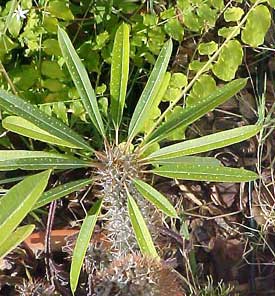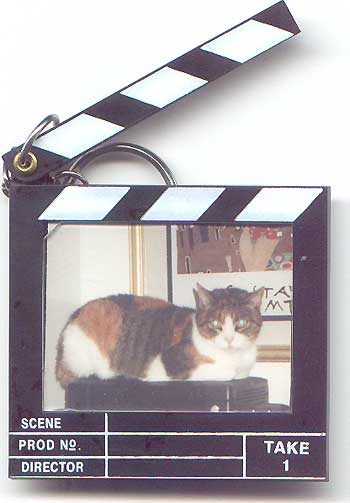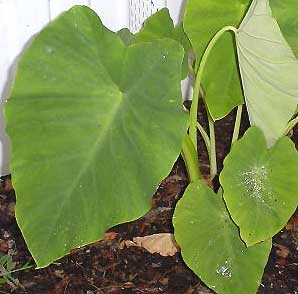Sunday, February 27, 2005
A fellow Florida blogger
Brian dropped me a note asking if I would link to his site. I'm so glad he did. Not only does he have a fantastic site, he's a fellow Floridian. How cool is that! Brian and his family live in Collier County (southwest Florida) on a "band-aid" lot. What's that you say? So did I. Their property is an elongated rectangle 75 wide X 660 feet deep hence the name. Brian chronicles his toils and tribulations at trying to return his land to a more natural state. Taming of the Band-Aid provides some gorgeously detailed pictures as well as great information about plants and insects. I finally learned that the little daisies leaving their seeds throughout my poor little guy's fur is called beggar-tick and I'll bet I know why - they beg any passing little animal to carry their seeds hither and yon to grow all over again. Anyway, go visit Brian's site when you get a chance. It's well worth the visit. Happy Florida Gardening.
Sunday, February 20, 2005
Tropical Plants Online does it again
 I opened my email this morning and there was a note from Tropical Plants Online talking about the Madagascar Palm. I read through the verbiage and then clicked on the pic and was astounded. Here finally was the name of the cactus we purchased a few years ago. As I'm sure you've figured out by now, we are big animal people. We love our pets and have had between 5 and 7 ever since we've been together. All rescues, over time they have aged and left us for the Rainbow Bridge.
I opened my email this morning and there was a note from Tropical Plants Online talking about the Madagascar Palm. I read through the verbiage and then clicked on the pic and was astounded. Here finally was the name of the cactus we purchased a few years ago. As I'm sure you've figured out by now, we are big animal people. We love our pets and have had between 5 and 7 ever since we've been together. All rescues, over time they have aged and left us for the Rainbow Bridge. 
Cali was my first cat and with me when my husband and I got together. She had been dumped in the apartment complex where I was living and was looking for a home. When I would come in from work, she would follow me inside the building and up the stairs. At the time I had a sheltie so I made a bargain with her. If she didn't give Missy a hard way to go, she was welcome to stay. Cali seemed to like that arrangement just fine and proceeded to totally ignore the dog. From that point on she was a permanent fixture.
Cali was with us until about 4 years ago when she developed kidney failure. She was 15 years old and I will forever miss her feisty yet loving antics. When she passed away we felt it only right to find a plant that fit her personality and we found the absolutely correct one. It had long strappy leaves that were soft and beautiful green, but also had lots of spikes on its trunk - exactly like Cali. She could be very warm and loving one minute, and slap you with her claws the next. Not labeled, we thought it was in the cactus family. We brought it home and it has grown. Our Cali plant has been through hurricanes and accidentally had bleach dropped on it (that's another long story) and still grows. So back to my tale. There in my email was a picture of the Cali plant. Only it's actually called Madagascar Palm or Pachypodium lamerei. It's a native of South Madagascar, Africa and IS a member of the cactus family - so we were correct! And, as you know, cacti can take a lot of abuse and still look great. So if you like the look of our Cali plant (minus the spots), go out to Karl's site at Tropical Plants Online and give one a home. You may even hear it purr. Happy Florida Gardening.
Wednesday, February 16, 2005
Elephant ears
 We're beginning the planning stages of the new garden in the backyard. Sunday was a gorgeous day - 70 degrees and sunny. So we took the opportunity to let the boys run in the back and envision the new garden space. We decided where to put the water feature, how to position a path for access, and where to build the dry bed for rain runoff. We also decided to keep the elephant ears exactly where they are.
We're beginning the planning stages of the new garden in the backyard. Sunday was a gorgeous day - 70 degrees and sunny. So we took the opportunity to let the boys run in the back and envision the new garden space. We decided where to put the water feature, how to position a path for access, and where to build the dry bed for rain runoff. We also decided to keep the elephant ears exactly where they are.I've always liked the look of elephant ears. They happily grow pretty much anywhere. And, to coin a well known phrase, they can really take a licking and keep on ticking. These plants got nailed by the hurricane winds last year and lived with soaked feet from the pond waters rising. When we had our lawn cutting guy, the poor things got ripped to shreds by his trimmer and were run over a few times around the edges. Yet they continue to bounce back and are sending out little babies.
I found a site, Emily Compost, that has a bazillion questions from folks all around the US who are growing elephant ears indoors and out. Well, maybe not a bazillion but pretty darn close. Anyway, I'm going to try taking one of the babies and placing it on the other side of the new garden to frame it in. I'll let you know how it goes. Happy Florida Gardening.
Friday, February 04, 2005
In praise of Wayside Gardens
Ever since I've been gardening I've received catalogs and ordered from Wayside Gardens. Their products are always very good quality and I have never been disappointed. When we lived up north, my husband and I had a Dawn Redwood growing in our yard. It is a fast growing tree and quite beautiful with its feathery type leaves. Since we've lived in Florida, we've wondered if we could possibly grow a Dawn Redwood here but never really looked into it. A few days ago the most recent Wayside Gardens catalog arrived in the mail and there on page 27 was a Metasequoia glyptostroboides aka Dawn Redwood. The description indicated it grows in zones 5-9.
Aha! Here's our chance to finally add a Dawn Redwood to our landscape we said. Then we started thinking - suppose it's not salt tolerant? Being so close to the water, can it take the salt exposure? I decided to contact Wayside and find out. I sent an email yesterday and received an answer about an hour ago - not exactly the answer I was hoping for but that's ok. Short answer - no it is not salt tolerant so we can still only dream of having this stately tree in our landscape. But here's the really cool thing that took a little sting out of the finding. I receive periodic emails from Chris at Wayside so I decided to reply and ask my question. I got a quick response saying that my question was being redirected to one of their horticulturists. The second response was sure enough from a horticulturist. How great is that! Not only do they acknowledge email requests, they actually respond when they say they will. Now that is great customer service.
Needless to say we are both disappointed but we'd rather dream about it than do the wrong thing by exposing the tree to the wrong elements and losing it. So we have our answer and will need to think about other trees to plant. I know we're going to add some pines. Guess I'll just have to start looking through some of my southern landscaping books and see what else strikes our fancy. Happy Florida Gardening.
Aha! Here's our chance to finally add a Dawn Redwood to our landscape we said. Then we started thinking - suppose it's not salt tolerant? Being so close to the water, can it take the salt exposure? I decided to contact Wayside and find out. I sent an email yesterday and received an answer about an hour ago - not exactly the answer I was hoping for but that's ok. Short answer - no it is not salt tolerant so we can still only dream of having this stately tree in our landscape. But here's the really cool thing that took a little sting out of the finding. I receive periodic emails from Chris at Wayside so I decided to reply and ask my question. I got a quick response saying that my question was being redirected to one of their horticulturists. The second response was sure enough from a horticulturist. How great is that! Not only do they acknowledge email requests, they actually respond when they say they will. Now that is great customer service.
Needless to say we are both disappointed but we'd rather dream about it than do the wrong thing by exposing the tree to the wrong elements and losing it. So we have our answer and will need to think about other trees to plant. I know we're going to add some pines. Guess I'll just have to start looking through some of my southern landscaping books and see what else strikes our fancy. Happy Florida Gardening.

This work is licensed under a Creative Commons License.
Thanks to Andrew Stenning who contributed the photograph for our masthead


